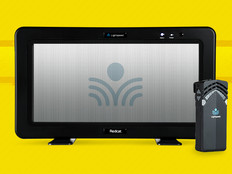How Schools Are Engaging Students With Interactive Whiteboards
Like many middle schoolers, Josh Hancock likes to see things for himself. Fortunately for Hancock, he attends Skycrest Christian School, where a comprehensive deployment of interactive whiteboards allows him to do just that.
"When our science teacher uses Google Earth to zoom in on a hurricane, it's more interesting than just listening to her explain hurricanes to us," says Hancock, an eighth-grader at the 425-student private pre-K-8 school in Clearwater, Fla. "And it gives me a lot clearer perspective."
Hancock also credits the boards with testing his knowledge more efficiently. For example, he notes that taking exams using a student response system, which anonymously posts students' answers to the classroom whiteboard, provides immediate feedback. By contrast, the results of traditional, paper-based testing are delayed by hours or days. Because interactive whiteboards enable real-time feedback, "I know my train of thought, and where I went wrong," Hancock says. "It's a better way to learn."
Skycrest's interactive whiteboard journey began in summer 2008, when husband-and-wife team Steven and Martha Clagg joined the staff as principal and technology director, respectively. At the time, Skycrest lacked the technology, leading the Claggs to seek permission from the school board to buy six units. To their astonishment, Steven Clagg recalls, the board approved the purchase of three times that number after one member asked, "If they're good enough for six rooms, why not every room?"
By late August 2008, Skycrest personnel were removing the dry-erase boards from the school's 15 second- through eighth-grade classrooms and replacing them with height-adjustable Promethean ActivBoard+2 systems. Roughly a year later, they installed the devices in the first-grade classrooms and the Spanish lab.
But Skycrest didn't stop there. It also turned to Promethean for student response systems, choosing ActiVote for the school's first- through fourth-graders and ActivExpression for the fifth- through eighth-graders. The school favored Promethean because of the company's focus on the education market, including its ongoing development of Promethean Planet, "an exceptional online lesson-sharing and collaboration community," Steven Clagg says.
Steps to Success
Technology installations alone don't guarantee success, of course, so Skycrest also developed a two-year transition strategy to ensure teachers acclimated quickly. At the beginning of the 2008-2009 school year, Steven Clagg says, the school asked teachers to do nothing more than "turn on the whiteboards, write on them and erase them."
Then, as the school year progressed, Skycrest began offering mandatory training sessions. "We emphasized that recording lessons with an interactive whiteboard during the first year was just like being a new teacher, where you're developing your lessons," explains Martha Clagg, a chemical engineer by training who doubled as a classroom teacher during her first two years at Skycrest. "We assured them that subsequent years would be a piece of cake."
Once the 2009-2010 school year started, teachers were given two months to develop at least one complete 30-minute lesson, in a core subject, that incorporated video and the student response systems. At the end of that two-month period, the principal and assistant principal, Michael Dyck, visited every classroom to evaluate teacher progress. "We were blown away by the lessons our teachers were already creating," Steven Clagg says of those demonstrations.
While satisfied with achieving those initial goals, the school has continued its professional development efforts. Today, Martha Clagg presents formal training sessions covering advanced features and functionality. Other dynamics, "such as what to do with the rest of the class when one student is at the board," also are addressed, she says.
There's also a mentor network, which provides ongoing training to anyone who needs it. The move allows the "techie" teachers to support those who are less savvy.
Bridge to the Future
Other successful interactive whiteboard adopters have followed a similar path. Chicago's Norman A. Bridge Elementary School, a public pre-K-8 facility serving 950 students, is but one example.
Last summer, the school completed a two-year installation of Hitachi StarBoard FXDUO interactive whiteboards in all 30 classrooms. Dr. Christopher Brake, the school's principal, worked with a committee of teachers and parents to find the right product. They chose the StarBoard, Brake says, because its electronics-free surface "still operates even if you put a ding in it" and because its on-screen controls make the device easy to use.
Kindergarten teacher and department chair Reem Evangelista is the school's designated interactive whiteboard trainer and champion. As the StarBoards were being installed, she gave every teacher a 30- to 40-minute introduction to the device. She also facilitated the six hours of training that teachers at every grade level received from Hitachi.
Even today, the training continues. "Formally, StarBoards are a regular agenda item during our staffwide meetings," Evangelista says. "Informally, we share ideas during weekly grade-level meetings, at lunchtime, before or after school – whenever we see each other."
Bridge teachers have shared their whiteboard knowledge externally as well. Last summer, they presented some of the StarBoard lessons that teachers are using in the school's classrooms at an annual Chicago Public Schools teaching summit.
According to Evangelista, the school's whiteboards have transformed teaching and learning in powerful ways. Teachers are seeing "improvements in student engagement and attention spans," she says, and students are learning faster and "at a deeper level." What's more, the devices are meeting "the needs of many different learning styles, including visual and tactile."
Brake, meanwhile, loves how the whiteboards have inspired his teachers to become "educational explorers." One teacher circumvented the inherent organizational challenges, expense and disruption of taking young people on a traditional field trip by using the StarBoard to bring an area museum's scientists into his classroom via video conference. "Busing the students to and from the museum for a similar one-hour presentation would have taken all day," Brake says.
The Ultimate Motivator
Interactive whiteboards are having an equally powerful effect at the district level. Over the past two years, for example, the IT team at Coffeyville Unified School District 445 has been working to make PolyVision's eno interactive whiteboards available in the southeastern Kansas district's 135 elementary, middle and high school classrooms and at 10 other learning spaces in the area.
James Elliott, the district's IT coordinator and assistant principal at Roosevelt Middle School, says the metallic enos were chosen for their resiliency and wireless functionality. "We needed a solution with minimal electrical requirements because two of our three school buildings are more than 75 years old," he explains. "With eno, the technology is built into the pen."
Colleague Ed Raschen, a geography and history teacher at Coffeyville's Field Kindley Memorial High School, says the eno saves him "at least 10 minutes" of class time each day. Because Raschen can now present lessons that automatically cue up rich content of various types, he's no longer "constantly interrupting a presentation to [manually] access visual content" on his computer.
Not surprisingly, students are responding to his new teaching style. On the 25th anniversary of the Space Shuttle Challenger disaster this past January, for example, Raschen showed a 90-second news clip from YouTube in class. "The next day," he recalls, "a student told me that he'd gone home, searched YouTube and watched the entire one-hour news broadcast from that time."
Raschen says that having the ability to "seamlessly interact with students on their level using YouTube" and other popular digital media sources motivates him to excel as an educator.
"Because I'm now inspiring my students to learn more, I leave school at night feeling great," he raves.
New Tricks
Colin Messenger, a senior consultant with Futuresource Consulting, says two best practices can boost the benefits that interactive whiteboards bring to the classroom experience.
- Use an iterative process to help teachers make the transition. During their first year using the devices, "teachers simply record everything," Messenger explains. "In the second year, they access what they saved the first year." During the third and fourth years, he adds, they have the competency to begin developing "more sophisticated" lessons.
- Encourage teachers to swap tips and lessons. This can be done onsite, online or, preferably, both, Messenger says.
Pam Trouville, a fifth-grade teacher at Skycrest Christian School in Clearwater, Fla., couldn't agree more. "The first time I saw an interactive whiteboard, it scared me to death," she says. "But it was amazing how quickly I could use the board and make it valuable in the classroom."
As her comfort with the technology increased, Trouville began collaborating with peers online to find new ways to enliven her lessons. "For social studies, I found a great lesson on Egypt with film clips already embedded in it," she enthuses.
Incorporating video is important, Trouville continues, because today's students are "more visual learners than they were in the 1970s, when I started teaching." Consequently, "anything visual I can do with the whiteboard is invaluable in sparking their interest."
50% of U.S. classrooms are expected to have interactive whiteboards by 2013. By comparison, about a third of them had the devices in early 2011.
SOURCE: Futuresource Consulting







